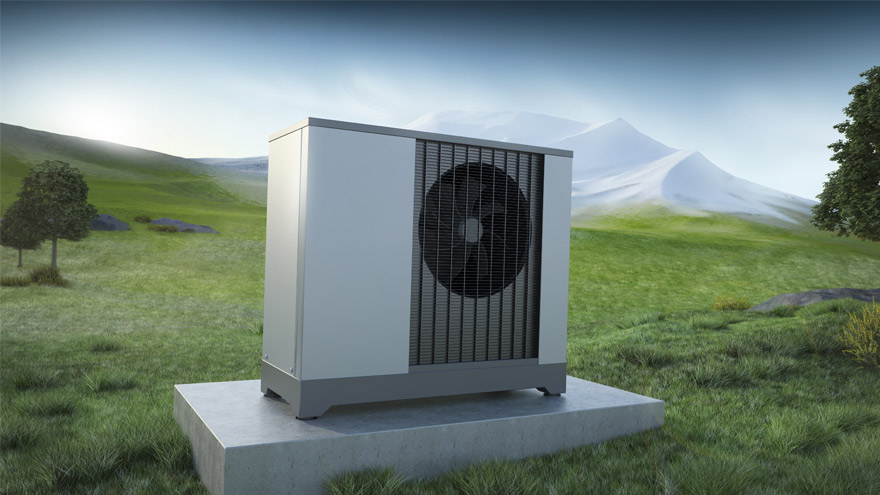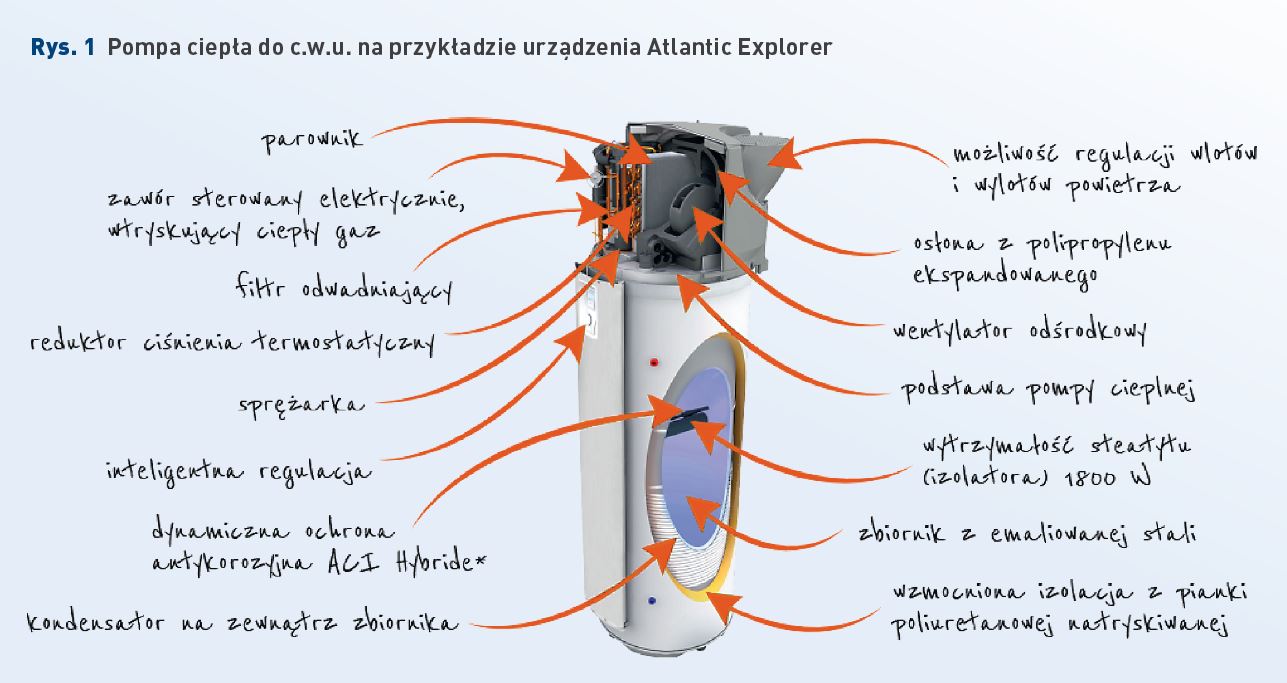Heat pumps for the production of hot water are devices that, in principle, do not differ in principle from heat pumps for central heating. The only difference is that the latter have the ability to both heat the building and heat domestic water (and many others: cooling, heating the swimming pool, etc.), while the ones that will be discussed in this article - only work for the production of domestic hot water. They are sometimes also called thermodynamic water heaters. The main difference in the structure of the device? Another compressor.

Small pumps for domestic hot water usually use small rotary compressors, of course on/off (with constant power), because the use of an inverter here would make no sense and would result in an unnecessary increase in the prices of such devices. And the price is undoubtedly their advantage. Prices of good quality heat pumps for domestic hot water for a family of 4 start from approximately PLN 5,000 net. Their installation is also simple and therefore relatively cheap, and the 230 V power supply and low power consumption mean that such a heat pump can be connected to virtually any electrical socket. Like a kettle. Just a little bigger. So let's discuss them in more detail.
Check out heat pumps for domestic hot water at the Onninen wholesaler
Construction of a heat pump
Since the heat pump is designed to produce hot water, it is a capacitive device that in most cases has an integrated water tank. Some manufacturers of this type of devices also offer versions without a tank, intended for installation with an existing water tank. This is a great solution if you do not want to replace an almost new hot water tank or have previously invested in an expensive stainless steel tank that will last for years. Most devices on the market, however, are compact units that include a heat pump, fan, water tank and controller, all enclosed in a more or less visually attractive common housing.
It should be added that these devices should be classified as monoblocks intended for indoor installation. They work by drawing in air using a fan, receiving heat from it and expelling the used air. The heat extracted from the air heats the refrigerant circulating in a closed system in the evaporator, which is additionally compressed by the compressor. In turn, a condenser (condenser) is wound on the water tank, in which the heated medium transfers its heat to the tank, thereby heating our utility water. There are also devices with a condenser immersed in the tank itself. The condenser should not be confused with a coil, as these devices may also be available in a version with an additional coil used to connect a central heating boiler or solar collectors that will support the production of hot water.

Operating characteristics of the domestic hot water heat pump
Heat pumps for domestic hot water are devices designed to operate on ventilation air, i.e. indoor air. Why? The temperature range of their operation is usually 7-35°C. Therefore, they cannot be operated outdoors all year round.
Of course, nothing stops us from building a duct system using Spiro or PVC pipes equipped with dampers, where we can draw air from the outside in the spring-autumn period. However, we must remember that we need to secure domestic hot water production for periods with lower outdoor temperatures. Manufacturers of heat pumps themselves come to our aid, as they are usually already built-in
electric heater.
A good solution is also to buy a pump with an additional coil and connect a central heating boiler to it, treating it in winter as a regular water tank heated by the boiler. Since heat pumps for domestic hot water circulate a relatively large amount of air during their operation (approx. 500 m3/h), ejecting cooled air, they should be installed in rooms with a sufficiently large volume and good ventilation. So not a broom closet, but a garage or basement. If this room is a boiler room, it should not be a coal-fired boiler room due to the contamination of this type of solid fuel, which could adversely affect the operation and service life of the device.
The above-mentioned specificity of the operation of heat pumps for domestic hot water, which consists in cooling exhausted air, makes it possible to additionally partially cool and dry the room in which it operates or to which we decide to direct the cooled air. Because this function is active only when heating water, i.e. under normal operating conditions for approximately 5 hours a day, it is best suited for cooling auxiliary rooms, e.g. pantries, laundry rooms, etc. We cannot control the cooling except by changing the flow direction. air using the damper. It must be clearly stated that it should not be treated as air conditioning. Despite the disadvantages of this solution, this function can be useful in the summer. Moreover, it does not cause any increase in operating costs, because it can be said that we use a side effect of the device's operation itself.
Each time when configuring the air duct system, the maximum permissible lengths of such ducts given by the device manufacturer in the operating manual should be taken into account due to the increasing air flow resistance. Some manufacturers offer ready-made ventilation kits dedicated to their devices. At the end of this technical analysis, some dry data. The COP efficiency of this type of devices ranges approximately from 2.5 to 3.9 for the EN16147 standard, i.e. with the following parameters: external air 15°C, water inlet temperature 15°C, water outlet temperature 55°C. As always in the case of all heat pumps, if we want to compare specific device models, it should be done according to the data given for the same air parameters and according to the same standard.
Check out heat pumps for domestic hot water at the Onninen wholesaler
Integration of the heat pump with the PV installation
Finally, it is worth spending a moment to discuss a recently popular solution, i.e. combining heat pumps with a photovoltaic installation. This solution gives us many benefits, especially in the case of air pumps that heat domestic water. It is known that in the summer we have the highest production from PV installations due to the highest annual amount of solar radiation reaching the earth's surface. Therefore, we also have the highest annual production surpluses of electricity, which we will give back to the power grid unconsumed and will later collect them somewhat "reduced".
What if this electricity could be collected in some other way? In the form of warm water? Nothing could be more difficult. Many of the domestic hot water heat pumps currently sold on the market can be operated with a PV installation inverter. This cooperation is based on establishing a certain production threshold in the PV installation, e.g. at the level of 80%, after exceeding which the photovoltaic inverter will give a signal to turn on the heat pump and heat the utility water to a slightly higher than usual temperature. In this way, we turn electricity that we would have to feed into the grid into hot water that we store and can use for an evening bath. We increase the auto-consumption of the produced electricity, which is very desirable when balancing the costs of photovoltaic installations.
Of course, before proposing such a solution to the client, you should always check whether both devices, i.e. the inverter and the heat pump, have the option of such cooperation. It may not be available in the cheapest versions of domestic hot water heat pumps available on the market. A mixing valve for domestic hot water will also be recommended in such a case, so that no one gets burned by water that is warmer than usual.
Summary
Despite the disadvantages of low heating power and a small range of external operating temperatures, heat pumps for domestic hot water are a good investment. Properly installed and operated, they will serve for a long time, producing cheap hot water. The cost of operating such a device for a family of four is approximately PLN 50 per month. Much cheaper than heating water in an electric boiler. Ease of installation and virtually no special operational requirements apart from a suitable room make them suitable for every household. The Technical Consulting Department provides assistance in selecting devices and appropriate solutions.
MSc. Paweł Leszczyński
Regional Technical Advisor – RES
Onninen Technical Consulting Department
Do you have questions about the industry? Join the Świat Instalacji group!
